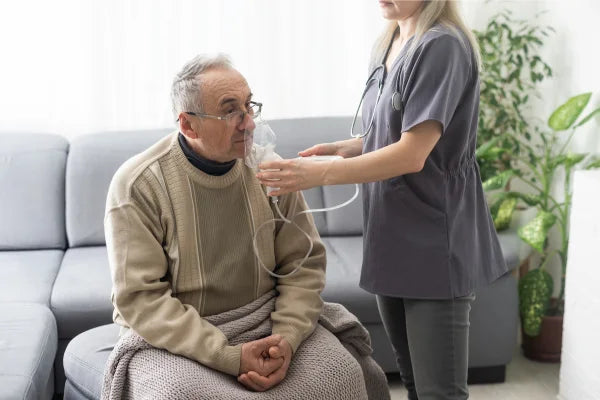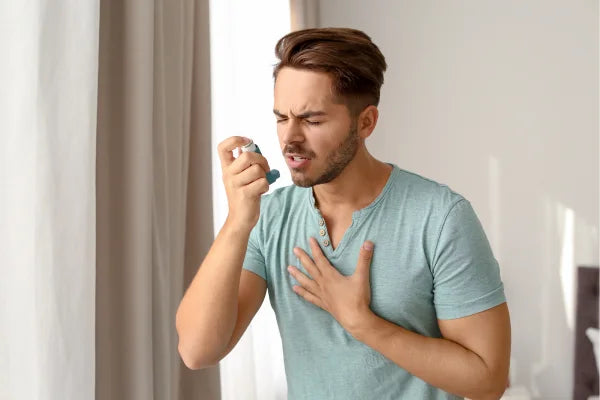
What is COPD? - Chronic Obstructive Pulmonary Disease (COPD)
Share
Chronic Obstructive Pulmonary Disease (COPD)
Listen to this Article
Table of Contents
- Overview
- Symptoms and Causes
- Diagnosis and Treatments
- Types of Chronic Obstructive Pulmonary Disease
- What Causes COPD?
- What Are the Risk Factors for This Condition?
- What Are the Complications of COPD?
- What Are the Stages of COPD?
- Preventing COPD
- Management and Treatment
Overview
Chronic Obstructive Pulmonary Disease (COPD) is a group of lung diseases that block airflow and make it difficult to breathe. COPD is primarily caused by long-term exposure to irritants that damage the lungs and airways, with smoking being the most significant cause. While COPD is a progressive disease, with early diagnosis and appropriate treatment, its progression can be slowed, and its symptoms managed.

Symptoms and Causes
COPD develops slowly over time, and its symptoms may initially be mild. As the condition worsens, the symptoms become more severe and noticeable. Common symptoms of COPD include:
- Chronic cough (often referred to as "smoker’s cough")
- Shortness of breath, especially during physical activity
- Wheezing and tightness in the chest
- Frequent respiratory infections
- Fatigue and lack of energy
- Increased mucus production
The primary cause of COPD is long-term exposure to harmful substances, most commonly cigarette smoke. However, environmental pollutants, occupational hazards, and genetic factors also contribute to the development of COPD.

Diagnosis and Treatments
To diagnose COPD, healthcare providers will typically perform the following tests:
- Pulmonary Function Test (Spirometry): This is the most common test used to measure lung function and determine the degree of airflow obstruction.
- Chest X-ray or CT Scan: These imaging tests help to identify changes in the lungs and assess the extent of the disease.
- Blood Tests: These tests help assess oxygen and carbon dioxide levels in the blood, which can be affected by COPD.
Treatment for COPD aims to manage symptoms and improve quality of life. It includes:
- Medications: Inhalers, bronchodilators, steroids, and antibiotics can help manage symptoms and prevent exacerbations.
- Quit Smoking and other toxic exposures: Ongoing smoking makes the symptoms worse and the lung damage is much faster. Smoking also increases the risks of COPD flare up episodes.
- Oxygen Therapy: For people with low oxygen levels in the blood, oxygen therapy may be necessary to improve breathing.
- Pulmonary Rehabilitation: A program that includes exercise, breathing techniques, and education to help improve lung function and overall health.
- Surgery: In severe cases, lung volume reduction surgery or a lung transplant may be considered.

Types of Chronic Obstructive Pulmonary Disease
COPD includes several conditions, mainly chronic bronchitis and emphysema. Here's an overview:
- Chronic Bronchitis: Characterized by inflammation of the bronchial tubes, which leads to excessive mucus production and a chronic cough.
- Emphysema: In this condition, the walls of the air sacs in the lungs are damaged, reducing the surface area for oxygen exchange and causing breathlessness.
In recent years we have now more knowledge of subtypes of COPD - also called COPD Phenotypes. You lung doctors may do some additional tests to find out what is your COPD Phenotype so your treatment can be more personalized to your needs and risks.

What Causes COPD?
The primary cause of COPD is long-term exposure to irritants that damage the lungs. These include:
- Smoking: The leading cause of COPD, responsible for approximately 85-90% of cases.
- Air Pollution: Exposure to pollutants from indoor and outdoor environments can damage the lungs over time.
- Occupational Hazards: Workers in industries involving dust, chemicals, and fumes are at a higher risk of developing COPD.
- Genetic Factors: A rare genetic disorder called alpha-1 antitrypsin deficiency can predispose individuals to COPD, even in the absence of smoking.
- Impaired Lung growth: Conditions that lead to suboptimal or impaired lung growth during perinatal phase (before birth), early childhood and teenage years can increase the risk of developing COPD in life.

What Are the Risk Factors for This Condition?
Several factors can increase the risk of developing COPD:
- Age: COPD is more common in people over the age of 40, with the risk increasing as people get older.
- Smoking: Long-term smoking is the single most significant risk factor for COPD.
- Family History: A family history of COPD or other lung diseases can increase the risk of developing the condition.
- Environmental Exposures: Long-term exposure to air pollution, occupational dust, and chemicals can also increase the risk of COPD.

What Are the Complications of COPD?
COPD can lead to a number of serious complications, including:
- Respiratory Failure: As the disease progresses, the lungs may be unable to provide adequate oxygen to the body.
- Frequent Respiratory Infections: People with COPD are more susceptible to infections such as pneumonia and bronchitis.
- Heart Problems: COPD increases the risk of developing heart disease, particularly right-sided heart failure.
- Lung Cancer: Individuals with COPD, especially those who smoke, have an increased risk of lung cancer.

What Are the Stages of COPD?
COPD is classified into different stages based on the severity of the disease. These stages are typically measured using the Global Initiative for Chronic Obstructive Lung Disease (GOLD) system:
- Stage 1 (Mild): Early COPD, with few symptoms and minimal impact on daily life.
- Stage 2 (Moderate): Increased shortness of breath and coughing, with symptoms affecting daily activities.
- Stage 3 (Severe): Significant limitation of airflow, requiring oxygen therapy and more intensive treatment.
- Stage 4 (Very Severe): Advanced COPD, with life-threatening symptoms and major restrictions on daily activities.
Apart from knowing the stage of COPD, it is important to know about the history of COPD flare up attacks. This can happen at any stage of COPD and can impact the lungs and disease course.

Preventing COPD
While COPD is often preventable, especially in cases related to smoking, there are steps you can take to reduce your risk:
- Quit Smoking: If you smoke, quitting is the most effective way to prevent COPD and slow its progression.
- Avoid Pollutants: Minimize exposure to air pollution, chemicals, and dust. Use protective equipment if necessary.
- Get Vaccinated: Vaccines, such as the flu and pneumonia vaccines, can help reduce the risk of respiratory infections that may exacerbate COPD.
- Exercise Regularly: Regular physical activity can help maintain lung function and overall health.

Management and Treatment
Although there is no cure for COPD, its symptoms can be managed through a combination of treatments:
- Medications: Bronchodilators, steroids, and other medications can help open the airways and reduce inflammation. In recent years we have may combinations of inhalers and oral medications that are very effective in managing COPD symptoms and slow down diseases progression and flare ups.
- Oxygen Therapy: Supplemental oxygen may be necessary for individuals with severe COPD.
-
Pulmonary Rehabilitation: A comprehensive program that includes exercise, education, and breathing techniques to help manage COPD symptoms.
- Lung Volume Reduction and Surgery: In some cases, bronchoscopic procedures or surgery can be performed to reduce the parts of the lung that are badly damaged and are now impairing the other parts of the lung to do their function. This procedure is called lung volume reduction. In advanced cases a lung transplant may be recommended.

Summary Points
- COPD is a progressive lung disease, mainly caused by smoking.
- Symptoms include chronic cough, shortness of breath, and frequent infections.
- Early diagnosis and appropriate treatment can slow disease progression.
- Management includes medication, oxygen therapy, pulmonary rehabilitation, and surgery.
- Quitting smoking is the most effective way to prevent COPD and slow its progression.
